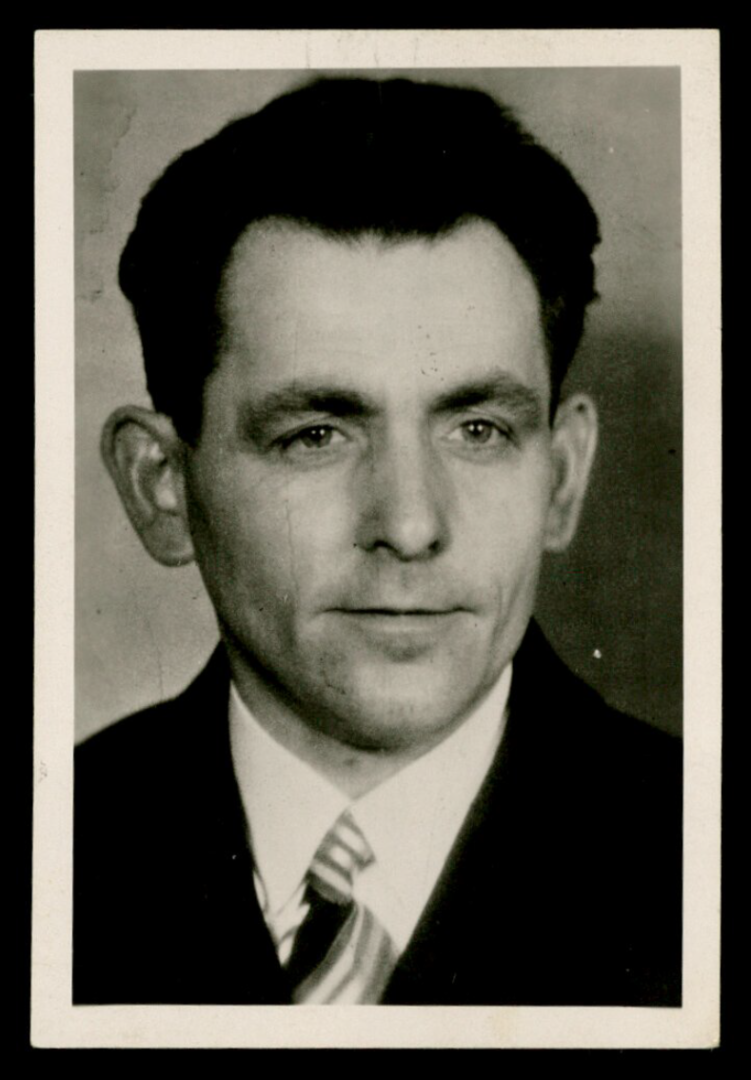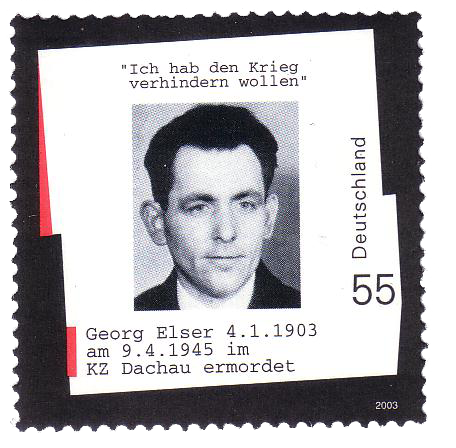How cruelly can a human being fail.
Georg ElserRead more:
† 09.04.1945 in Dachau Concentration Camp
Nationality at birth: German
Nationality at death: German
Ludwig Elser
* 1872, Ochsenberg† 11. August 1942
Maria Müller
* 29. December 1879, Heidelberg† 1960
Manfred Bühl
* September 1930, Konstanz† 1997
Place of the fight for human rights: Munich
| Area | Type | From | To | Location |
|---|---|---|---|---|
| Primary School | ||||
| Carpenter |
Red Front Fighters' League
Location:Reason for entry: Interests of the working class
Function / Activity: Passiv
Prizes, Awards
Stamp by “Deutsche Post”, 2003
Freedom was very important to Johann Georg Elser and he wanted to prevent the war, that is why he planned and attempted the assassination of Adolf Hitler.

INTRODUCTION
It took a long time for Georg Elser to receive the recognition that for example Claus Schenk Graf von Stauffenberg received, although Elser, too, carried out a bomb attack against Hitler. Elser had wanted to prevent the war. And he tried it single-handedly. In the end, all that remained was his realisation: “How cruelly can a human being fail.”
THE STORY
Georg Elser was born on 4 January 1903 in Hermaringen (Württemberg). He was the eldest of five children, although one of his brothers died in childhood. His family lived in difficult and poor circumstances in Königsbronn. Georg Elser was an illegitimate child, his parents did not marry until a year after his birth. His father was an alcoholic and beat his wife and children. Elser had to help and work in the family from an early age, in the fields and in his father’s timber trade. He attended primary school (“Volksschule”) and taught himself to play the flute and the accordion.
Elser had to abandon his first apprenticeship as an iron turner for health reasons, after which he began an apprenticeship as a carpenter, which he completed. Georg Elser changed jobs several times due to the difficult economic conditions after the First World War. In Constance, he stayed longest. There, he began a love affair with Mathilde Niedemann in 1928, from which a son, Manfred Bühl, was born in 1930. Beginning in 1933, he had another love affair with Elsa Härlen, with whom Elser presumably had one or two children, although nothing more is known about this. Georg Elser had not had a job since 1932, so he moved back to his hometown and supported his family by working there. He made furniture in a small workshop. During this time Elser also taught himself to play the zither and the bass. In 1928/1929 Elser joined the paramilitary organisation of the KPD (Communist Party of Germany), the Red Front Fighters’ League (“Roter Frontkämpferbund”). However, he showed no real commitment there and remained a passive member.
Georg Elser voted for the KPD until 1933 because he considered it the best representation of workers’ interests and was also a strong opponent of National Socialism overall. He never took part in National Socialist demonstrations and he always refused to give the Hitler salute, thus also publicly expressing his rejection. Also, he always left the room when Hitler gave a speech on the radio. Reasons why Elser was an opponent of the Nazi regime included the worsening living conditions of the working class and also the growing danger of war in Nazi times, which he recognised early on.
All in all, Elser was always looking for ways to stand up for workers’ interests. He did not want to accept the existing conditions and sought his individual solution to eliminate what he saw as an anti-working-class system. Based on his observation of foreign policy developments, by autumn 1938 Elser had come to the conclusion that war was inevitable. Preventing this impending war was a central motive of his act. Disturbed by the palpable suppression of freedom of belief and religion and the restriction of individual freedom, Elser was firmly convinced that leaflets would not be enough to prevent this war. The entire Nazi leadership had to be eliminated.
For the planned bomb attack, Georg Elser moved to Munich, where Hitler gave a speech every year on 8 November in the “Bürgerbräukeller” (a large beer hall in Munich) on the occasion of the Hitler putsch in 1923. Elser built the explosive device completely on his own and stole 250 pieces of pressed powder from his employer, the Heidenheim armature factory, for it. He also began working in a quarry in order to obtain explosives. Every evening for 30 days he hid in a broom closet in the “Bürgerbräukeller” until all the guests and employees had left. During these 30 nights, Elser hollowed out the supporting column behind Hitler’s lectern so that he could place the explosive device there. The aim was to bring down the ceiling and kill Hitler with the detonation. The bomb did explode at the exact time Elser had set.
On this anniversary of the Hitler putsch, 8 November 1939, Hitler did not actually intend to take the podium himself, but instead had the NSDAP politician Rudolf Hess speak. Hitler decided to give a speech anyway, but it was considerably shorter, as he had to return to Berlin immediately afterwards. Hitler left the “Bürgerbräukeller” with other Nazi leaders at around 9:07 p.m., but the explosive device did not detonate until 9:20 p.m., which was exactly the time Elser had planned, but the assassination attempt on Adolf Hitler thus failed. A total of eight people were killed in the attack, seven NSDAP members and the waitress Maria Henle, and over 60 were injured.
On the same night that the attack had taken place, the Reich leader of the SS, Heinrich Himmler, set up a special commission consisting of officers from the criminal investigation department and the secret state police (“Gestapo”). The crime scene commission was led by the criminalist Hans Lobbes and the perpetrators’ commission by SS-Obersturmbannführer Franz Josef Huber. Georg Elser was arrested by two customs officers before the explosion, on the evening of 8 November at 8.45 pm, because he had tried to enter Switzerland illegally. Individual items in Elser’s bags aroused suspicion after the customs officers learned of the attack. These included a picture postcard of the “Bürgerbräukeller”, a badge of the Red Front Fighters’ League and parts of the time fuse. The Gestapo took Elser to the state police station in Munich, where he was interrogated and tortured, and all his belongings, which were stored at his sister’s place, were confiscated. Georg Elser confessed his crime in detail on the night of 13 to 14 November 1939 after days of torture and interrogation. During his confession, Elser also explained his motives and convictions, which were recorded in the protocols. He was interrogated again at length in Berlin between 19 and 23 November. Since the Nazi regime feared being perceived as weak if it came to light that a single person had planned and carried out an attack on Hitler, they invented the story that Georg Elser worked for the British Secret Service. Elser’s entire family was also arrested and interrogated for months, his sister was held for two years.
In 1941, Georg Elser was sent to Sachsenhausen Concentration Camp as a special prisoner. The plan of the Nazi regime was to have him sentenced in a show trial before the People’s Court after the war. Elser had a solitary cell in the concentration camp, where he was guarded around the clock by two SS guards. In his cell, Elser had a workbench with which he made furniture for the guards and a zither for himself. During his time in Sachsenhausen Concentration Camp, he had no contact at all with other prisoners.
At the beginning of 1945, Georg Elser was transferred by the Gestapo to the Dachau Concentration Camp, where he was also held as a special prisoner. In Dachau, Elser’s cell door was opened during the day, but a guard stood in front of it day and night. When it was foreseeable that there would be no trial due to the course of the war, Hitler ordered Elser’s execution in April. On 9 April 1945 at around 11 p.m., Georg Elser was murdered by being shot in the neck on the execution square in Dachau concentration camp after five years in prison. His body was burned with his clothes and his ashes were scattered. There was no grave. Several other resistance fighters were executed on the same day, including Dietrich Bonhoeffer. Only 20 days later, the Dachau Concentration Camp was liberated by American soldiers.
Georg Elser’s family did not learn of his fate even after 1945 and he was not declared dead until 1950; the relatives received no compensation for Elser’s imprisonment or death. For a long time it was disputed among Germans whether Elser had really acted completely on his own. Many believed in the rumour that he in fact had been a member of the SS. Against the famous aristocrats and generals of the Stauffenberg assassination attempt of 20 July 1944, a simple worker like Georg Elser had little chance of being noticed. It was only towards the end of the 1960s that Elser’s interrogation transcripts were found, which clarified his motivation, his courage, his meticulousness and his view of the development of the Nazi regime. In the 1980s to 1990s Georg Elser’s assassination attempt and he himself finally received the appropriate tribute.
Author: Jonah Piechocki, student at Gymnasium Eickel in Herne. Member of “AG-Menschenrechte” 2021/22.
Sources:
https://georg-elser.de/ (Gedenkstätte Deutscher Widerstand)
https://www.lpb-bw.de/georg-elser-dossier
https://www.br.de/radio/bayern2/sendungen/radiowissen/geschichte/georg-johann-elser-thema100.html
https://www.kz-gedenkstaette-dachau.de/geschichte-online/dachauer-ton-spuren/georg-elser/
https://www.gedenkstaetten-bw.de/elser-hintergrund
https://georg-elser-arbeitskreis.de
Schauder, Olaf. Gegen Hitler und den Krieg: Der Attentäter Johann Georg Elser. Eine biographische Untersuchung und Vorschläge für eine Behandlung des Themas im Geschichtsunterricht der Hauptschule. GRIN Verlag, 2002.
Image Johann Georg Elser: With friendly permission of Schweizerisches Bundesarchiv (E4320B#1970/25#2*)
Contact: info@fritz-bauer-bibliothek.de






